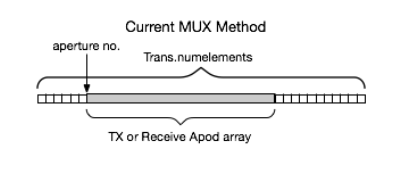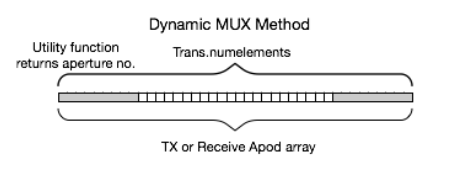Dynamic HvMUX Programming Model
Multiplexed transducers have multiplex circuits in the transducer body or connector that allow connecting a subset of elements to the number of channels in the system. For example, the L12-3v transducer has 192 elements, of which 128 can be selected and connected to the 128 I/O channels of the system connector. Verasonics currently supports multiplexed transducers by providing a number of fixed aperture configurations that can be selected by specifying an aperture number in the TX or Receive structures. For linear arrays, the apertures available are contiguous sets of elements the same size as the number of system channels that can be moved across the full aperture of the transducer by an element at a time. In the current programming model, the TX and Receive apodization arrays are sized the same as the sub-aperture, and therefore apply to the subset of elements selected, rather than the full array.

The current programming model works well for linear arrays, where the aperture desired is usually a contiguous group of elements that can be moved across the face of the array to acquire a frame of image data. However, for 2D arrays, this model is very restrictive, since there are thousands of possible apertures that might prove useful, and it would not be possible to pre-define all possible apertures. In addition, many transducers have multiplexer circuits that allow connecting more than one element to a specific channel. Supporting this capability allows utilizing more transducer elements than the number of system channels for certain scanning modes.
The new multiplexer programming model allows dynamic creation of multiplexer apertures, based on the TX or Receive Apod arrays, which are extended to cover all the elements in the transducer. The user can define the active elements in the aperture for a specific transmit or receive action, and then call a utility function to compute the multiplexer switch pattern and return an aperture number for use in their setup script. The utility function warns if multiple elements are connected to the same channel, or if the apodization pattern is inconsistent with the multiplexer switch configuration.

For linear arrays, the new dynamic programming method allows creation of non-contiguous apertures, as shown above, and for some transducers, all elements can be made active for transmitting a full aperture plane wave. The new method is especially useful for multiplexed matrix arrays, such as those used with the 1024 MUX Universal Transducer Adapter (UTA). For example, random 256 element sparse apertures can be created, or active elements can be clustered around a specific origin point on the array. The flexibility of being able to create arbitrary sub-apertures will allow experimenting with different volume scanning methods and optimization of acquisition sequences for various applications.
11335 NE 122nd Way, Suite 100
Kirkland WA 98034

